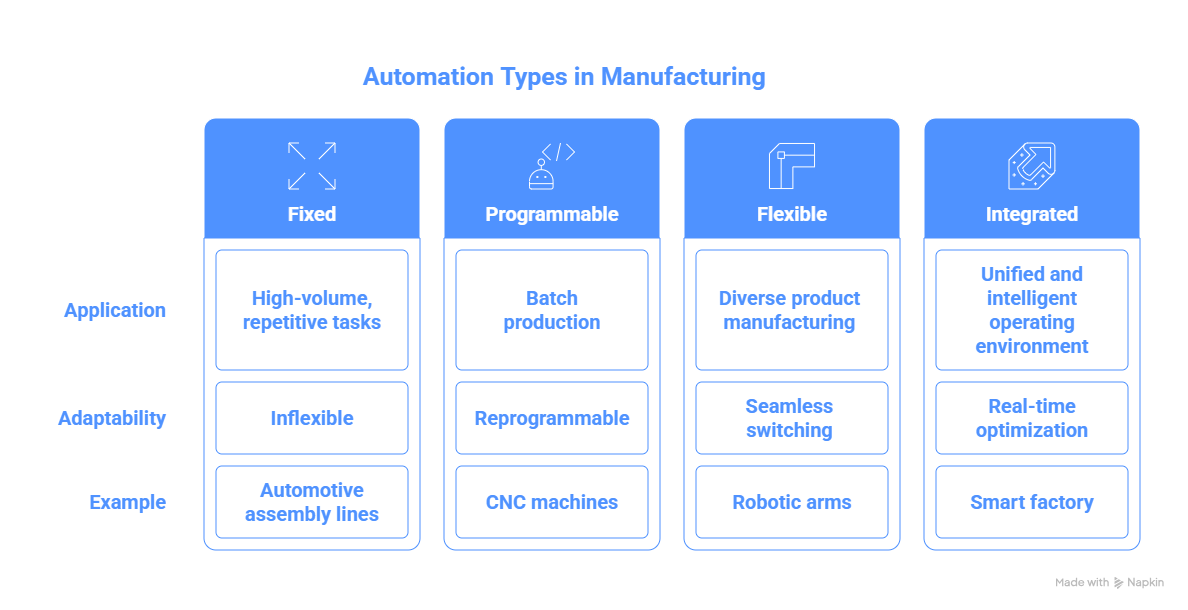%20(21).png)
For More Information
Contact us!.png)
%20(37).png)
Dipesh Patel is the President & CEO of DP Gayatri, partnering with OEMs and Contract Manufacturers to automate and scale operations. A seasoned management consultant and graduate of the UofM Carlson School of Management, he brings strategic leadership to a portfolio of manufacturing and automation companies delivering factory automation, contract assembly, facility relocation and expansion, and supply chain localization across the U.S. and Latin America.
Automation is revolutionizing industries across the globe, transforming the way businesses operate by streamlining processes, reducing costs, and improving overall efficiency. From manufacturing plants using robotics to service sectors implementing advanced software, automation is reshaping how work gets done. With various types of automation systems available - ranging from fixed automation in assembly lines to intelligent, adaptive systems powered by AI - it’s crucial to understand their unique applications and benefits to make the most of their potential.
This article dives deep into the different types of automation, explaining their core elements and levels of adaptability, while identifying real-world examples that demonstrate their immense impact. Whether you're looking to optimize production, reduce human error, or enhance the customer experience, understanding automation is key to staying ahead in today’s fast-evolving technological landscape.
Automation in manufacturing plays a pivotal role in enhancing production efficiency and reducing manual errors. What are the four types of automation systems commonly used in the industry? Let's break it down:
1. Fixed Automation
Fixed automation involves systems designed for high-volume, repetitive production, such as automotive assembly lines. These systems are preprogrammed to perform specific tasks, making them cost-effective for large-scale production but inflexible for any changes or new tasks.
2. Programmable Automation
Ideal for batch production, programmable automation allows businesses to reprogram machinery for different tasks or products. For example, CNC machines used in tool manufacturing can be reconfigured to create various custom components.
3. Flexible Automation
Flexible automation takes adaptability a step further. It enables systems like robotic arms to seamlessly switch between product types without extensive reprogramming. This makes it perfect for industries requiring diverse product manufacturing within shorter time frames.
4. Integrated Automation
Integrated automation combines control and information systems to create a unified and intelligent operating environment. A smart factory, for instance, utilizes integrated automation to synchronize production lines, monitor performance, and optimize processes in real time.
By leveraging these systems, manufacturers can achieve superior outputs, minimize downtime, and realize higher adaptability. These different types of automation in manufacturing demonstrate the variety and depth of automated technologies available to meet production demands.

Automation systems rely on essential components that work together to ensure smooth and efficient operation:
1. Sensors and Detectors
Sensors gather data such as temperature, pressure, or motion. They form the “eyes” of automation, detecting conditions in real time and feeding data to the system.
2. Controllers (e.g., PLCs)
Programmable logic controllers (PLCs) act as the brain, interpreting data from sensors and making decisions based on programmed logic. The result? Precise control over processes.
3. Actuators
Actuators execute the system’s commands by performing physical actions, such as moving robotic arms or opening and closing valves.
4. Communication Networks
Communication systems link all automation components, ensuring seamless coordination. Common types include Ethernet, Wi-Fi, and industrial protocols like Modbus.
5. Human-Machine Interface (HMI)
HMI systems allow operators to interact with automation systems, providing visual displays, control inputs, and diagnostic tools for efficient monitoring.
These components work together seamlessly to ensure precise processes, improve efficiency, and provide consistent repeatability in manufacturing workflows. By integrating advanced technology and streamlining operations, they help reduce errors, enhance productivity, and maintain high-quality standards across production cycles.
Levels of automation in manufacturing are often categorized within distinct stages of automation maturity, which coincide with the system’s ability to function independently of human intervention:
1. Manual Operation
Processes entirely dependent on human effort with little or no technological assistance.
2. Assisted/Manual Automation
Systems provide basic support, such as warning systems or mechanical aids, but humans still play a critical role.
3. Semi-Automated Processes
Machines perform most tasks, but human intervention is required for supervision and occasional input.
4. Fully Automated Systems
Entire processes are automated, requiring minimal human input (primarily for maintenance and troubleshooting).
5. Intelligent/AI-Driven Automation
Systems powered by artificial intelligence function autonomously, using machine learning and real-time data to adapt and optimize processes.
Each level represents a step toward greater efficiency and reduced human dependence, with intelligent automation paving the way for future innovation.
Please reference the following to better understand what are the types of automation with examples:
1. Fixed Automation
Example: Conveyor belt-driven bottling plants. This system ensures high speed and volume but lacks flexibility in product types.
2. Programmable Automation
Example: CNC machines in tool manufacturing. Via reprogramming, the same machine can create various custom components.
3. Flexible Automation
Example: Robotic arms reprogrammed for diverse products. Frequently seen in electronics or automotive manufacturing.
4. Integrated Automation
Example: Fully synchronized smart factory setups, where sensors and controllers communicate seamlessly to optimize the manufacturing process.
Each type addresses different needs, providing tailored solutions depending on business requirements.
Automation is key to staying competitive in today’s manufacturing landscape. By understanding the benefits of automation in manufacturing, businesses can implement the right solutions for their particular needs. Contact DP Gayatri to explore intelligent automation solutions designed to streamline your operations and enhance productivity.
